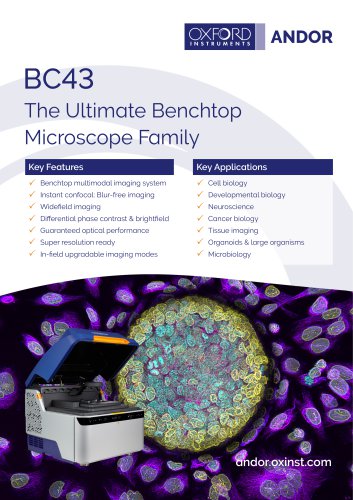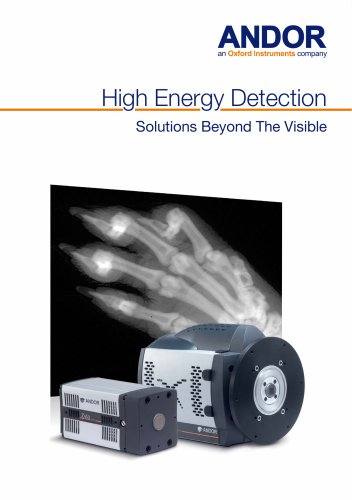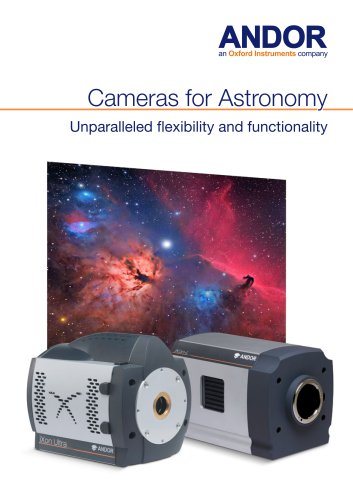
カタログの抜粋

Scientific CMOS Neo and Zyla sCMOS Cameras Widen Your Expectations Including the new Zyla 4.2 • 4 Megapixel • > 70% QE • 100 fps • <1 e- read noise
カタログの1ページ目を開く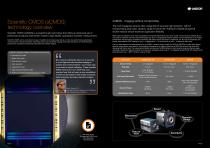
Scientific CMOS (sCMOS) technology overview sCMOS - Imaging without compromise Scientific CMOS (sCMOS) is a breakthrough technology that offers an advanced set of performance features that render it ideal to high fidelity, quantitative scientific measurement. Scientific CMOS can be considered unique in its ability to simultaneously deliver on many key performance parameters, overcoming the ‘mutual exclusivity’ associated with current scientific imaging technology standards, and eradicating the performance drawbacks traditionally associated with CMOS imagers. • Extremely low noise • Rapid...
カタログの2ページ目を開く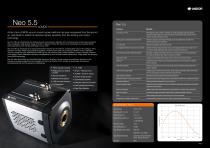
Maximum exposure and readout flexibility across all applications. Snapshot for ‘interline CCD’ exposure capability Offers lower detection limit than any CCD 5.5 megapixel sensor format and 6.5 μm pixels Delivers extremely sharp resolution over a 22 mm diagonal field of view: ideal for cell microscopy, digital pathology, high content screening and astronomy Dark Noise Suppression (DNS) technology Extremely competitive low darkcurrent of 0.14 e-/pix/sec with fan cooling. Maintains low noise advantage across range of exposure conditions Rapid frame rates >30 fps over extended kinetic series....
カタログの3ページ目を開く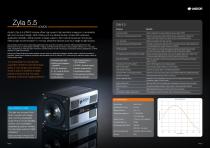
• Rolling and Snapshot exposure • 0°C cooling @ up to 35°C ambient • 25,000:1 dynamic range • Superb image quality • Quantitative stability • Fast exposure switching • Cost effective • Data Flow Monitor Maximum exposure and readout flexibility across all applications. Snapshot for ‘interline CCD mode’ freeze frame capture of fast moving/changing events Offers lower detection limit than any CCD Dark Noise Suppression (DNS) technology Extremely competitive low darkcurrent of 0.14 e-/pix/sec with fan cooling. Maintains low noise advantage across range of exposure conditions ‘10-tap’ Camera...
カタログの4ページ目を開く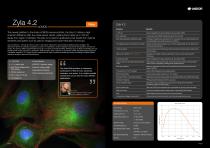
• Cost effective • Dark Noise Suppression • Superb image quality Technology • Quantitative stability • 100 fps sustained • Fast exposure switching • 0.9 e- noise @ 40 fps • 4.2 Megapixel Kurt Thorn, Assistant Adjunct Professor, UCSF School of Medicine, California Lowest read noise sCMOS. Significantly lower than any CCD Dark Noise Suppression (DNS) technology Extremely competitive low darkcurrent of 0.14 e-/pix/sec with fan cooling. Maintains low noise advantage across range of exposure conditions 4.2 megapixel sensor format and 6.5 μm pixels Delivers extremely sharp resolution over a 18.8...
カタログの5ページ目を開く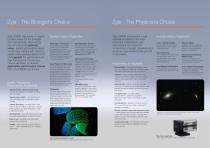
Zyla - The Biologist’s Choice Zyla sCMOS has proven a superb camera choice for the biologist and microscopist. Many simply see the Zyla as an amazing value, superb price/performance ‘workhorse’ camera with which to replace their existing interline CCD and upgrade the performance of their fluorescence microscope. Others are driven by distinct application performance criteria that only sCMOS can answer. Quality, Throughput, Performance, Accessibility… – High Sensitivity & Wide Dynamic Range – quantify very weak and very bright structures with one image. – Superb Image Quality – high...
カタログの6ページ目を開く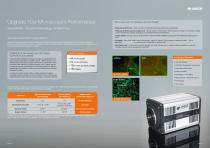
Upgrade Your Microscope’s Performance Why is Zyla such an impressive all-round imager? Zyla sCMOS - Disruptive Technology, Familiar Price • Superior performance – vastly superior to interline across key performance parameters. • Rolling and Global exposures (Zyla 5.5) – Zyla is unique in offering both these exposure modes in one camera. Global shutter (snapshot) is directly analogous to the interline exposure mechanism. • Image quality – a huge amount of effort and on-camera (FPGA) intelligence has gone into optimizing image quality in Zyla. What was the benchmark imaging detector?...
カタログの7ページ目を開く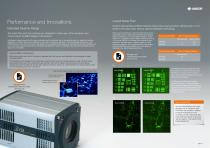
Performance and Innovations Extended Dynamic Range The Andor Neo and Zyla cameras are designed to make use of the innovative dual ‘column-level’ amplifier design of the sensors. Traditionally, sensors require that the user must select up-front between high or low amplifier gain (i.e. sensitivity) settings, depending on whether they want to optimize for low noise or maximum well depth. The dual amplifier architecture of the sCMOS sensor circumvents this need, in that signal can be sampled simultaneously by both high and low gain amplifiers. As such, the lowest noise of the chip can be...
カタログの8ページ目を開く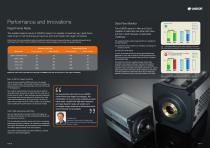
Data Flow Monitor Rapid Frame Rates The parallel readout nature of sCMOS means it is capable of reaching very rapid frame rates of up to 100 full frames per second, and much faster with region of interest. Distinctively, this is accomplished without significantly sacrificing read noise performance, markedly distinguishing the technology from CCDs. Andor’s sCMOS cameras are uniquely designed to harness this speed potential. The sCMOS sensor in Neo and Zyla is capable of extremely fast data read rates, but this in itself imposes considerable challenges. For sustained kinetic series...
カタログの9ページ目を開く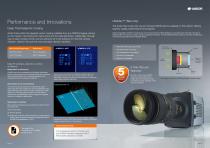
UltraVac™ (Neo only) The Andor Neo is the only vacuum housed CMOS sensor available on the market, offering superior quality, performance and longevity. Deep Thermoelectric Cooling Andor’s Neo offers the deepest sensor cooling available from any CMOS imaging camera on the market, minimizing both darkcurrent and hot pixel blemishes. Additionally, through use of water cooling, the fan can be switched off in the software to minimize camera vibration, ideal for set-ups that are particularly vibration sensitive. sCMOS @ -40ºC Andor’s proprietary UltraVac™ process has a proven track record of...
カタログの10ページ目を開く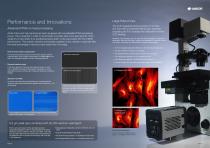
Performance and Innovations Advanced FPGA on-head processing Andor’s Neo and Zyla cameras are each equipped with considerable FPGA processing power. This is essential in order to dynamically normalize data at the pixel level for minor variations in bias offset, thus eradicating fixed pattern noise associated with this CMOS phenomenon. This superior dynamic processing capability is also utilized to optionally filter the small percentage of spurious noise pixels from the image. Large Field of View The multi-megapixel sensors present in the Neo and Zyla offer an extended field of view,...
カタログの11ページ目を開くAndor Technologyのすべてのカタログと技術パンフレット
-
Marana sCMOS
9 ページ
-
MicroPoint 4
9 ページ
-
ZL41 Cell sCMOS
7 ページ
-
Sona sCMOS
9 ページ
-
Optistat
11 ページ
-
Multi-Wavelength Imaging
11 ページ
-
BC43
13 ページ
-
Solis-Brochure
6 ページ
-
iKon-M/L SO Series
10 ページ
-
iStar CCD and sCMOS
8 ページ
-
Neo 5.5 sCMOS
6 ページ
-
Mechelle 5000
5 ページ
-
Spectroscopy Brochure
25 ページ
-
Apogee Alta F9000
5 ページ
-
Apogee Aspen CG230
5 ページ
-
Apogee Aspen CG47
5 ページ
-
Apogee Aspen CG6
5 ページ
-
ApogeeAspen CG9000
5 ページ
-
iXon EMCCD
13 ページ
-
iVac OEM 2
2 ページ
-
iKon-M OEM 2-page PV
2 ページ
-
iKon-M X-Ray 2
2 ページ
-
Newton EMCCD
16 ページ
-
iQ Software
12 ページ
-
sCMOS
16 ページ
-
Low Light Imaging
8 ページ
-
Darkcurrent
3 ページ
-
Revolution
23 ページ
-
Clara Flyer
2 ページ
-
PRODUCT PORTFOLIO 2013
51 ページ
-
Revolution DSD
11 ページ
-
iXon
33 ページ
カタログアーカイブ
-
Astronomy Brochure_2014
19 ページ
-
Astronomy Brochure
19 ページ




